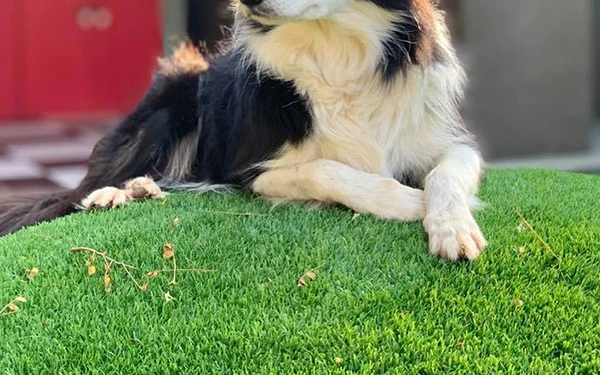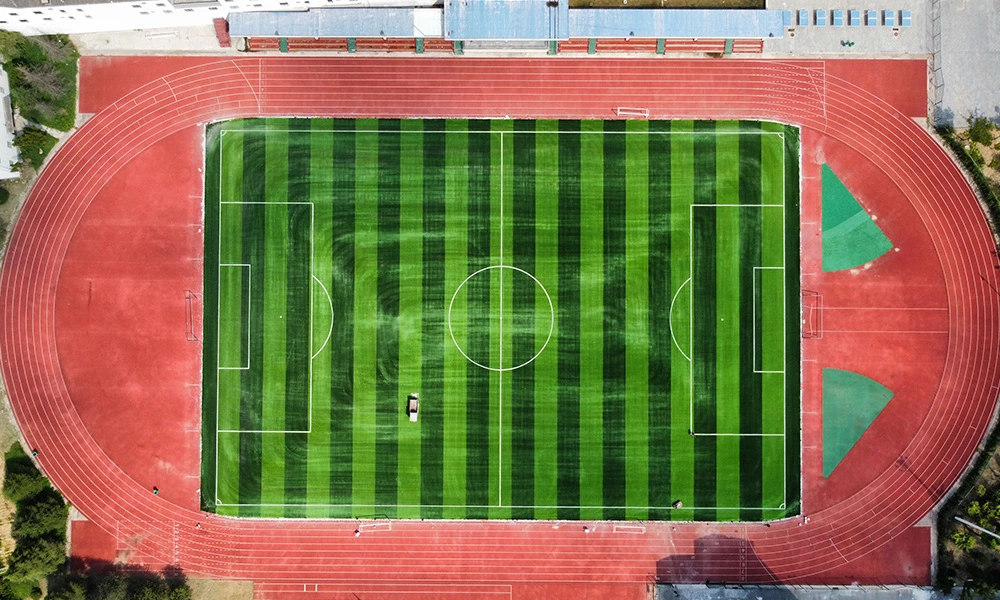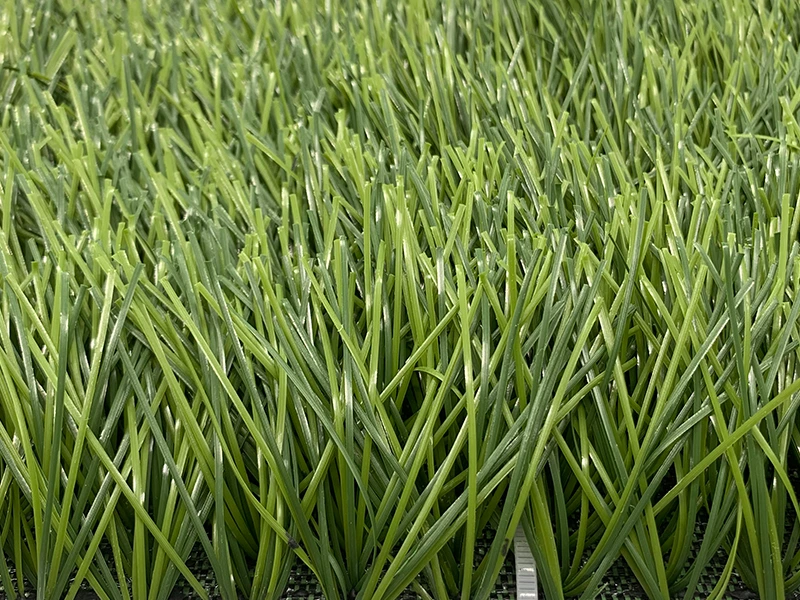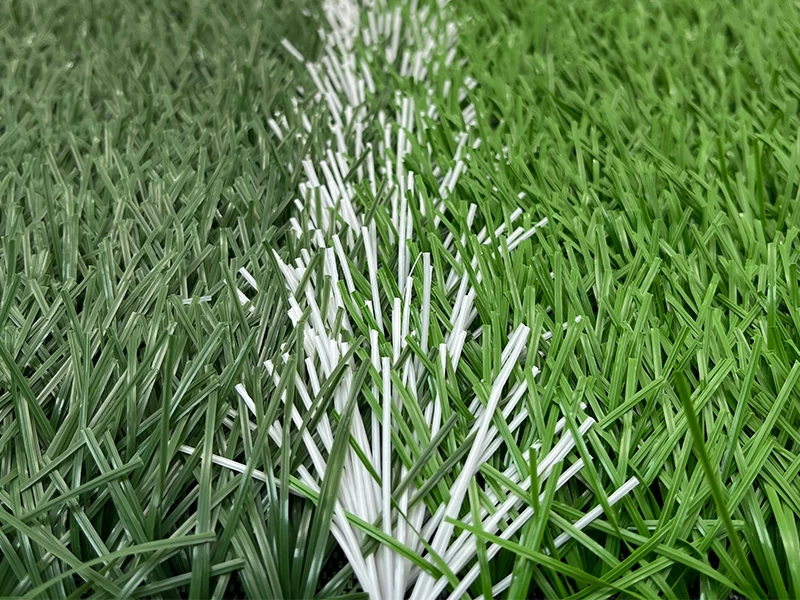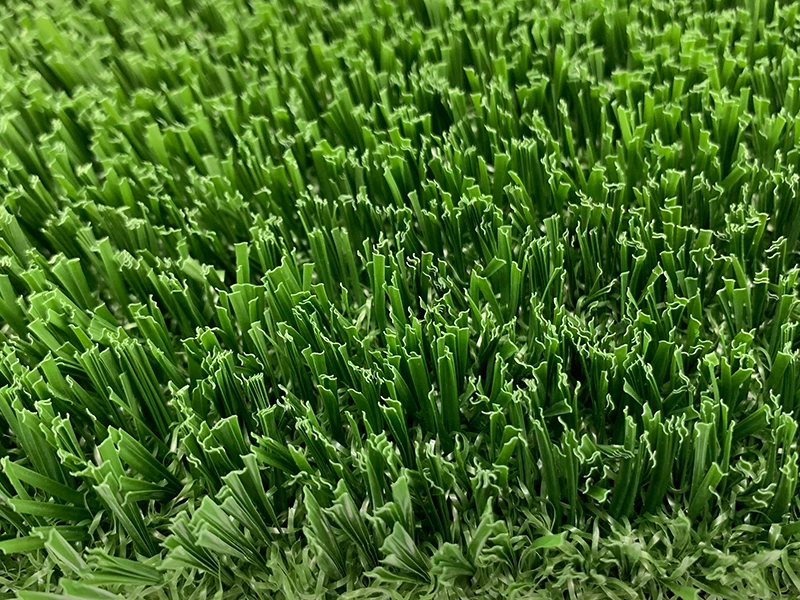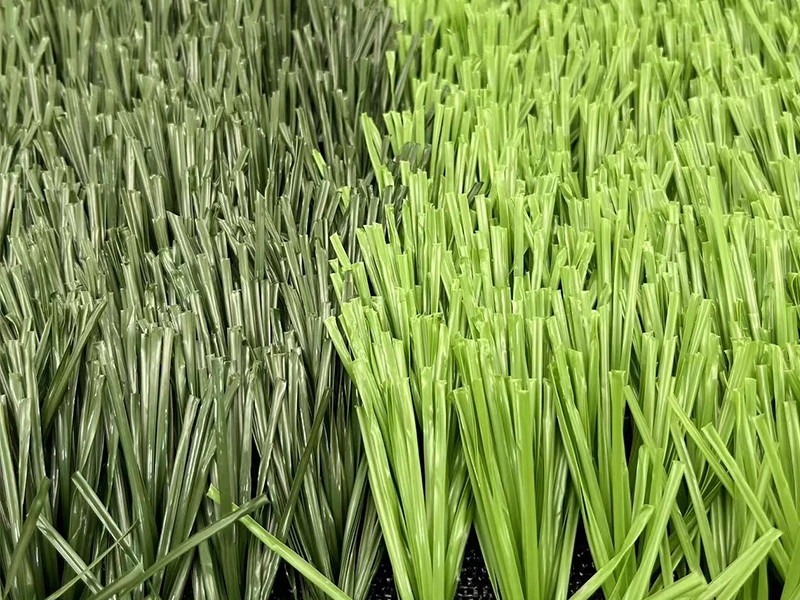Artificial grass for dogs: Advantages & Installation
What is artificial turf for dogs?
Artificial turf for dogs is a synthetic grass designed for pets. It is wear-resistant, non-slip, and weather-resistant, and can withstand the frequent activities and scratches of pets. Its materials are environmentally friendly and non-toxic, and do not contain chemicals that are harmful to pets. It is easy to clean and maintain, which helps to keep the yard or indoor environment clean.
This kind of lawn usually has good drainage performance, which can quickly drain rainwater or pet urine and avoid water accumulation and odor. The grass is soft and realistic, which is comfortable and safe for pets to play, rest or train on it. At the same time, it reduces the need for water and trimming of natural lawns, making it an ideal choice for family pet activity space.

What are the benefits of artificial turf for pets?
Save water
Replacing natural grass with artificial turf can significantly reduce the need for watering, thereby significantly reducing water bills. This is not only helpful for your budget, but it is also an environmentally friendly lifestyle that reduces the water waste required for daily maintenance of natural turf.
Durable, dig-proof pet turf
Pet-friendly artificial turf provides pet owners with a low-maintenance and highly durable playground. Our turf is designed to withstand daily use, whether it is digging, scratching or running, it can remain intact. Compared with the disadvantages of natural turf that is easily damaged by pets, artificial turf shows excellent wear resistance and is not easy to fall off or damage. Therefore, pet owners can rest assured that this turf will remain strong and durable even after long-term use, providing a reliable play space for their pets.
Reduce maintenance costs
After installing artificial turf for pets, there is no need to mow, fertilize or reseed. Compared with the tedious maintenance of natural turf, artificial turf eliminates these troubles and saves time and energy. Even if your pet uses it frequently, the condition of the turf will remain the same.
Clean and beautiful lawn experience
Artificial pet lawns completely say goodbye to the trouble of mud and dirt, so that your pet will not bring dirt into the house after playing. No matter what the weather is, the lawn always remains clean and beautiful, and green all year round. It not only improves the overall appearance of the yard, but also creates a comfortable activity environment for your pet.
Pest-free, allergy-free healthy lawn
During the installation of artificial turf, cleaning and compacting the base can effectively remove the environment where pests live and prevent mosquitoes and pests from breeding. In addition, the allergens in the natural lawn will disappear, no longer causing allergic symptoms in family members, so that pets and family members can enjoy outdoor activities with peace of mind.
How to lay artificial grass for pets?
When laying artificial grass for dogs, it is important to choose the right base material to ensure the functionality and safety of the lawn. Here are some common base materials and their benefits:
Stone layer
Before laying artificial grass, you first need to lay a base layer. This is usually made of crushed stone or broken bricks, which can provide good drainage and prevent water accumulation. The base layer also increases the stability of the lawn, making it less likely to deform or settle.
Sand layer
On top of the base layer, a layer of sand is usually laid. This layer of sand fills the gaps between the base layers and makes the ground more flat. In addition, the sand layer can help water drain away quickly and keep the lawn dry.
Weed cloth
In order to prevent weeds from penetrating the artificial lawn, it is necessary to lay a layer of weed cloth on top of the sand layer. This layer of cloth can effectively prevent weeds from growing, and it will not affect the drainage performance of the lawn.
Buffer layer
On top of the weed cloth, you can choose to lay a buffer pad. This cushioning layer is usually made of rubber or foam and provides extra comfort and safety, especially for active dogs who love to run and jump. This cushioning layer not only reduces pressure on your dog's joints, but also prevents them from getting injured.
Artificial turf glue
When laying artificial turf, you need to use a special glue to fix the turf to the cushioning pad or ground. This glue has good adhesion properties and can ensure that the turf does not loosen or shift under the dog's activities.
By choosing the right base material and professional laying methods, you can create a safe, comfortable and easy-to-maintain artificial turf for your dog. This not only allows your dog to play freely, but also reduces the cleaning and maintenance workload for the owner.
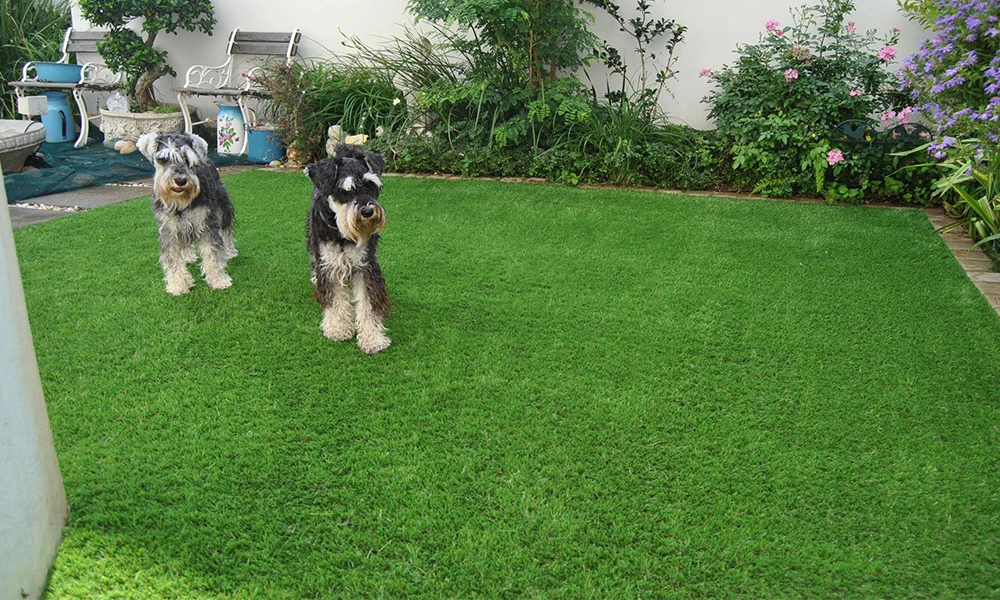
How much does pet lawn cost?
The price of pet lawn varies depending on the material and specifications, but generally the material price is between $2.50 and $6.20 per square foot. The installation cost is about $10 to $15 per square foot.
What is the difference between artificial turf and pet turf?
Although all artificial turf is pet-friendly, pet-specific turf is optimized for special needs. This type of turf is usually shorter and harder to withstand high-intensity activities, especially suitable for places such as doggy day care centers, commercial dog parks, and kennels. Ordinary landscape turf is more focused on aesthetics and softness, and may not be suitable for spaces where pets frequently move around.
How to prevent your pet lawn from smelling?
To prevent odors from accumulating, it is recommended to rinse regularly with plenty of clean water and use a disinfectant to eliminate bacteria. For light cleaning, you can use a mixture of water and vinegar; or choose a cleaning tool with a hose disinfectant attachment.
For the best odor prevention effect, it is recommended to choose a complete pet lawn solution, which includes antibacterial padding, lawn deodorizer and drainage system. Continuous cleaning and care can effectively keep the lawn fresh. It should be noted that if the odor has penetrated the lawn seriously, it may be difficult to completely remove it, so daily maintenance is very important.
What is the best artificial turf for dogs?
Short turf fibers for easier cleaning
UNIGRASS pet turf is designed with short fibers to simplify cleaning. Short turf is easier to sweep and rinse, while maintaining good appearance and elasticity under frequent pet trampling. Compared with high turf, short turf effectively reduces tangling and ensures freshness and cleanliness. If you prefer plush or high-fiber turf, you can also choose our other products, but it is recommended to strengthen daily maintenance to prevent odor accumulation.
Wear-resistant materials for long-term use
UNIGRASS pet turf uses durable and high-strength blade structure materials with excellent wear resistance, which can keep the turf soft and tough even after long-term use. Whether it is active pets chasing and playing or daily use, the turf is always as good as new.
Low-density design ensures efficient drainage
UNIGRASS has specially designed low-density artificial turf for pet areas. Its excellent drainage performance can quickly penetrate liquids and prevent water from being retained on the surface of the turf. This design is very suitable for places where pets are active, such as pet parks or home courtyards. It is easy to clean and disinfect, giving pets a comfortable and hygienic activity space.
UNIGRASS pet lawns are also weather-resistant and environmentally friendly, providing a safe and comfortable green environment for pets and owners. You are welcome to purchase pet lawns in our online store, or order samples for comparison to find the product that best suits your needs.
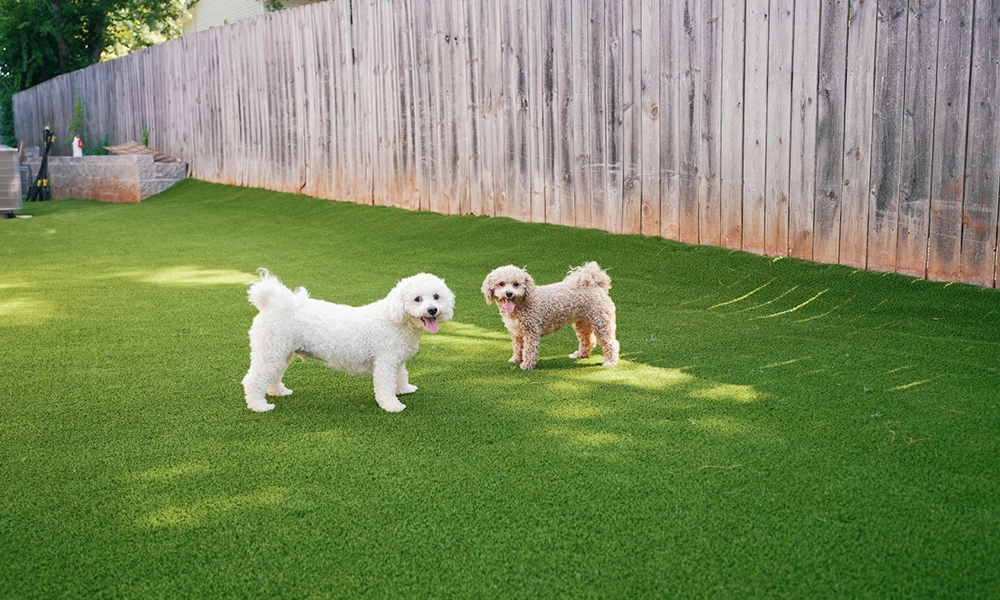
How to maintain artificial turf for pets?
Although maintaining artificial turf for pets does not require the same tediousness as natural turf, it does require some basic care to keep it clean and hygienic. Here are some maintenance tips for sharing artificial turf with pets:
Cleaning up pet feces
Remove pet feces promptly to avoid attracting flies or emitting odors.
Use a shovel or paper towel to clean up solid feces.
Wipe with wet wipes or rinse with a hose for any remaining parts.
If the feces are hard, soften them with water before cleaning, and use soapy water or enzyme cleaners if necessary.
Dealing with pet urine
Dog urine will drain out through the lawn's drainage system, but regularly flushing the urine area can help avoid odors.
Use a hose to flush areas where pets often urinate.
If there is an odor problem, scrub with soapy water or spray with a mixture of baking soda and vinegar, then rinse with clean water.
Special deodorizers are also available on the market to remove stubborn odors.
Cleaning up debris
Regularly clean leaves, twigs, and dirt from the lawn to prevent bacterial growth and pest infestation.
Pick up large debris manually or use a leaf blower or soft-tooth rake.
Vacuuming
Vacuuming is an effective way to remove pet hair and small debris.
For small lawns, use a household vacuum cleaner without a stiff brush.
For larger lawns, hire a professional team to use commercial vacuum equipment.
Rinse regularly
Occasionally hose down your lawn, especially in areas where pets hang out.
Rinse to remove dust, hair, and odors, keeping your lawn clean and fresh.
Brush sideways
Regularly brushing against the direction of the grass fibers will help them stand upright and maintain a fluffy appearance.
Brushing is especially effective in areas where pets often lie or where there is a lot of traffic.
